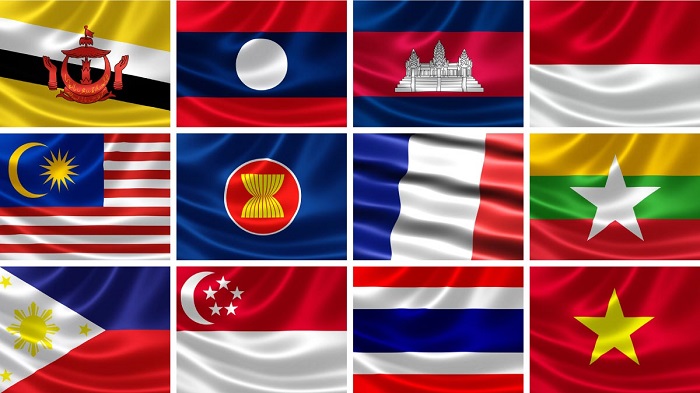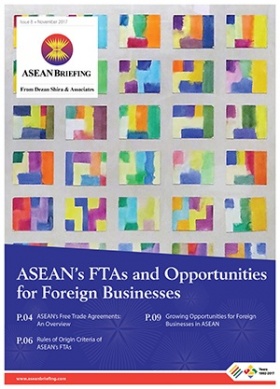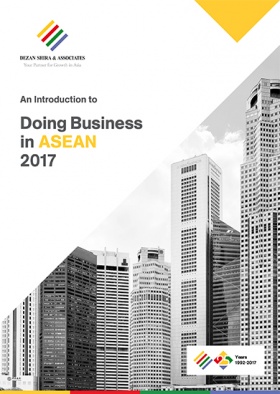French FDI in ASEAN Part I: Singapore, Malaysia and Vietnam
Editor: Thibaut Minot
The business environment of the Association of Southeast Asian Nations (ASEAN) has become increasingly favorable for foreign investment in recent years. 2014 was an exceptional year in terms of FDI, which gave way to a slightly less impressive 2015 despite significant FDI flows of about EUR102 billion (US$126.7 billion). FDI flows remained strong in the areas of finance and infrastructure and strengthened in the manufacturing sector. France’s FDI was no exception: the French FDI stock in ASEAN reached EUR17.4 billion (US$21.6 billion) at the end of 2015, with a penchant for large markets (Malaysia, more than EUR 104.7 million) and those with development prospects (Vietnam, more than EUR 81 million).
This is due to the willingness of governments in ASEAN states to promote foreign investment and the increasingly visible economic developments in the region. The weakening of the Chinese and Brazilian markets, the creation of the ASEAN Economic Community in December 2015, and the streamlining of the regulatory landscape greatly improved the perception of investors. Be it SMEs or multinationals, they now want to expand their presence in the economic region through the creation of various investment routes, production networks and regional headquarters. Despite being rich in opportunities, ASEAN remains a difficult region to define. It is therefore crucial to understand the different advantages and disadvantages that each country offers and to choose accordingly.
![]() RELATED: Pre-Investment and Market Entry Advisory from Dezan Shira & Associates
RELATED: Pre-Investment and Market Entry Advisory from Dezan Shira & Associates
Singapore: land of innovation and new technologies
Singapore is now one of the top ten FDI destinations in the world. Defined by the World Bank as the second easiest country to do business after New Zealand, the city-state acts as a hub in the region with an efficient regulatory system, great freedom for foreign investors and tax incentives. The World Economic Forum places Singapore in 1st place in Asia for the protection of Intellectual Property. In 2015, Singapore was the leading destination for French investors in the region, accounting for 61.6 percent of French FDI in ASEAN, or EUR 10.7 billion (US$13.2 billion). In 2016, French sales in the city-state increased by 14.9 percent compared to the previous year, reaching EUR 6.1 billion (US$7.5 billion).
Singapore’s geographic location, infrastructure and the level of middle class population make it possible to undertake an immeasurable number of sectors, be it high-tech, retail or high-end added value manufacturing. The trajectory of some industries, however, remains to be emphasized.
The information and communication technology sector: driving other industries
The performance of the ICT sector is part of Singapore’s development strategy, which target the growth of current industries through innovation, better digital connectivity and urban-industrial modernization with the Smart Nation initiative. With the goal of becoming the world’s first “smart nation” in 2025, all technology start-ups (with 100 percent foreign capital) are welcome and can benefit from public funding and technological competitiveness clusters. It should be noted that 40 percent of start-up acquisitions in Asia are in Singapore and 60 percent of Singapore-based startups receive additional financing. Startup incubators and accelerators thrive and are supported by various initiatives: for example, the Technology Incubation Scheme (TIS) finances 85 percent of the investments of about 15 incubators. This focus on ICT creates opportunities in a variety of areas, such as health (mobile apps for a digital single window of information and health-related services) and education (digital education). More importantly, this surge in ICTs is a major contributor to the manufacturing of high value-added products in the manufacturing sector, such as electronics, biomedical devices, transportation networks and equipment, the automotive industry, robotics and renewable energy.
Regular and expected growth: consumption and financial services
With a GDP per capita of EUR 44,825 (US$55,708) in 2015 (third highest in the world) and a solid middle class, the opportunities are numerous in the retail trade, food services and entertainment services in general. Singapore’s market is complemented by ASEAN’s total market, as Singapore serves as a regional export hub. The financial sector remains at the heart of FDI in Singapore, accounting for 49.8 percent of total FDI. The city-state continues to be seen as a gateway to investing in ASEAN and Asia. The ease with which a company can be created, the double taxation agreements and the tax advantages make Singapore an ideal destination.
Study: French technology companies in Singapore
Singapore had 714 French entities at the beginning of 2017, with 681 subsidiaries of large companies, ETIs and SMEs as well as 33 branches or representative offices. In 2015, it also included 330 French entrepreneurs (a figure that has only increased since then) in various fields, including services and new technologies seeking to take advantage of this startup-friendly environment.
The city-state attracts French technology companies thanks to its undeniable expertise in the field and a workforce more than qualified. Ubisoft, the French leader in video games, founded a studio in Singapore in 2008 located at Fusionopolis, an R&D complex. In 2013, Ubisoft Singapore became the largest development studio in Asia, pushing the parent company into the second-largest production force of any video game publisher in the world. Orange Business Services will launch soon a set of cloud services on a global scale (digital transformation, smart cities), managed entirely from the Singapore office. As for the other major French groups, these focus on aeronautics and defense: we can mention Dassault System and Accor, but also ENGIE and Thales, which opened highly sophisticated research centers because of the pro-innovation environment of the country.
Malaysia: E & E manufacturing and high value-added industries
Malaysia has experienced annual average GDP growth of 6.4 percent since 1970. Despite a slight decline in recent years, the trajectory remains robust and is expected to hover around 4 percent in 2017, making it a good fit for its 11th Five-Year Plan whose goal is to transform Malaysia into a high-income country in 2020. The country has rapidly diversified its economy, favoring growth today based more and more on ICT, services (more than 50 percent of GDP) and foreign investment. However, the manufacturing sector remains solid (more than 20 percent of GDP), particularly in the electrical and electronics sector, according to the Statistics Department of Malaysia.
FDI in the country increased from MYR 36 billion (around EUR 7.09 billion) in 2015 to MYR 50 billion (EUR 9.85 billion) in 2016, representing an increase of 40 percent. The majority of investments were made in the manufacturing sector (51.2 percent), followed closely by the services sector (47 percent). It is also important to note that a significant increase in GDP per capita is forecast for 2017, which would result in an increase in the level of consumption. Opportunities therefore arise for companies in industries such as retail or food services, opportunities all the more supported by the push of e-commerce. The Malaysian Digital Economy Corporation has defined 2017 as “the year of the Internet economy,” and the recent appointment of Jack Ma as Digital Economy Advisor only confirms this.
French-Malaysian trade increased by 6.8 percent in 2016 to reach EUR 3.7 billion. This is illustrated in particular by the growth of exports and imports (+ 6 percent and + 7.9 percent respectively). There are many factors, between aeronautical exports (EUR 730 million, mainly due to Airbus’ delivery to Air Asia) and imports related to computers and electronics. In fact, mechanical, electrical, electronic and computer equipment accounted for 67.1 percent of French imports from Malaysia in 2016, counting for EUR 1456 million. The big surprise of 2016 was in the field of refined petroleum products, where French purchases reached EUR 122 million (compared to EUR 7 million in 2015, + 1714.5%). In general, the decline in the ringgit has strongly favored economic flows between our two countries, and the regular demand for electronic components in France and on a global scale suggests stable trade in the long term.
Electrical and Electronics: main strengths of the Malaysian Manufacturing Sector
The electrical and electronics industry (or E & E) is today the major force of the manufacturing sector, attracting a considerable volume of foreign investment and creating jobs in quantity. In 2016, a total of 107 projects in the E & E industry were approved, resulting in a total investment of MYR 9.2 billion, 86 percent of which was FDI from Germany, the United Kingdom and China. Indeed, foreign investors dominate the electricity industry with flows amounting to MYR 4.1 billion, or 94.3 percent of investments. The projects “in vogue” are particularly in the field of solar energy and include the manufacture of cells and photovoltaic modules. Similarly, foreign investors dominate the fields of electronic components and consumer electronics products, occupying respectively 85 percent and 99 percent of total investments in 2016. Finally, other manufacturing industries with lower FDI flows also represent a strong potential: we can especially mention the machinery and equipment sector (M & E), where the work on advanced technology (Big Data, Cloud, Internet of Things) is perceived as crucial for the economic success of the country and galvanize the service sector.
Incitement to implementation
The terrain is fertile for foreign multinationals to establish themselves in ASEAN, with a young, educated and multilingual population, infrastructure and subsequent quality connectivity and incentives. The Main Incentive Hub Policy, launched in 2015, encourages multinationals to use Malaysia as a base for their regional and global business activities with tax and non-tax benefits (optimization of costs and resources, rationalization of the chain, etc.). Various other benefits are advanced by the Malaysian government.
Study: French companies encouraged in Iskandar
A megalopolis under construction with the goal of attracting 3 million people in 2025, the new “Shenzhen of Malaysia” is a futuristic city where residential towers, shopping malls and modern industrial zones are being built at full speed. In comparison with Singapore, Iskandar prides itself on a cost of living well below the latter and can become the place of choice for entrepreneurs and large companies wishing to do business in both countries. About fifteen French companies have already settled there. Technip, a giant in the energy sector, has set up its Asiaflex subsidiary in Iskandar to connect to all major shipping routes in Asia, combining construction, transportation and installation in Asia Pacific, Australia and the Middle East. Since its installation in Iskandar, METabolic EXplorer, a biochemistry company for the manufacture of daily products, has only extended its activities in the area in response to demand from Asian markets.
Vietnam: manufacturing powerhouse and emerging consumer market
Vietnam is at a crossroads. Usually associated with the CLMV group (Cambodia-Laos-Myanmar-Vietnam), the country has begun to detach itself from its peers in terms of FDI flows, with obvious competitiveness clusters for companies of the manufacturing sector seeking mass and low-cost production; and an emerging middle class now seeking new products and services.
Vietnam has posted sustained GDP growth since the early 2000s, at 6.2 percent in 2016 and 6.7 percent in 2015 according to the World Bank. This development over the last 20 years has resulted in a strong consumer base with a GDP per capita growth between 5 and 6 percent and GNI per capita of US$6,050 in 2016 (compared to US$910 in 1990). In recent years, this has resulted in a diversification of its various sectors, including manufacturing and services (33 percent and 50 percent of GDP respectively in 2015).
 RELATED: ASEAN’s Free Trade Agreements: An Overview
RELATED: ASEAN’s Free Trade Agreements: An Overview
Bilateral Trade
Bilateral Franco-Vietnamese trade has increased in recent years, with a significant growth of 43.3 percent in 2015 and 9.2 percent in 2016, amounting to EUR 6 billion. Deliveries of Airbus to Vietnam Airlines and VietJet Air (EUR 709.7 million) are obviously the strong points of French exports but pharmaceutical exports (EUR 219.3million, + 25.6 percent), agricultural products (EUR 39.3 million, + 152.6 percent) and agribusiness (EUR 156 million, + 17.4 percent) are not left behind. One of the reasons would be the opening of access to the market of several agri-food products, such as beef, as well as the rise in popularity of French cereal products (EUR 19 million, compared to EUR 9 million in 2015). Vietnam’s imports to France grew by 10.6 percent in 2016 and are concentrated in textile and electronic products (77 percent of total imports). The textile-clothing-footwear sector is particularly welcome, with imports amounting to EUR 1.9 billion in 2016. In these areas of the manufacturing sector, Vietnam is indeed the largest ASEAN partner of France.
A manufacturing hub
FDI flows have steadily increased in recent years, rising by 28 percent in 2015, to reach US$11.8 billion. 67 percent of this new inflow was in the manufacturing sector, led by South Korea. Vietnam is today the Korean electronic production hub and the leading destination for Korean FDI in ASEAN, with the presence of multinationals such as Samsung Electronics and LG. In 2014, Samsung invested US$2 billion in the installation of a smartphone manufacturing plant in Thai Nguyen province, US$1.4 billion in the household appliances sector and is preparing to invest in infrastructure projects.
The years 2015-2016 were also marked by FDI in the textile industry, mainly from Korea, Japan, Mainland China and Taiwan. Singtex, a manufacturer of high-tech fabrics for companies such as Nike and Timberland, has just opened its first factory last year. With wage increases and reorientation to higher value-added products in countries such as China, Vietnam is emerging as a textile manufacturing center with significant production capacity, low wages and incentives trade policies.
An emerging consumer market
Meanwhile, Vietnam is also an attractive destination for companies looking for a sales market. The Lotte Group, one of South Korea’s largest conglomerates in the food processing, retail, construction and logistics sectors, has continued to open new shopping centers in Vietnam and is currently aiming to operate a chain of 60 supermarkets across the country in 2020. For other supermarket brands seeking to expand such as E-Mart, Ho Chi Minh City is seen as a base for strategic expansion from which other countries such as Laos or Cambodia can be reached.
A Franco-Vietnamese synergy?
Following the 2013 Vietnam-France strategic partnership, bilateral trade has only intensified with annual growth of 15 percent. The second largest European investor after Germany, France is among the top 10 countries with the largest number of projects in Ho Chi Minh City, with 185 projects equivalent to US$848 million, out of 496 French projects in the whole country (US$3.43 billion). One could mention Airbus, which recently sold 40 aircraft to Vietnamese airlines, or Alstom, which, with Colas Rail and Thales, signed in early 2017 a contract of EUR 190 million for the construction of a Metro system for line 3 in Hanoi. SMEs are already well advanced in certain industries such as agribusiness, currently the second largest sector for French investors after transport and infrastructure. It would be crucial to think about areas where future demand will emerge, such as health, the environment and urban planning.
Study: French companies in the manufacturing sector
For French companies, production potential in Vietnam is becoming more obvious. Following its acquisition of Ly Sinh Cong last year, Lectra, the French leader in textile technology solutions, has established itself in Ho Chi Minh City. According to Yves Delhaye, associate manager of the region, a large number of textile and automobile manufacturers have chosen Vietnam as a production area, including very large Asian groups. This decision has allowed Lectra to better respond to a growing demand and to help Vietnamese companies and newcomers to galvanize their production with new technologies. French electronics giant, Scheinder Electric has completed the construction of its new plant in the Saigon High Tech Park (SHTP) with an investment amounting to US$ 45 billion. Serving the ASEAN and Australian markets with high-tech products for smart homes, this structure is one of the largest in the multinational’s history. In addition to costs, one of the reasons why they chose Vietnam is the country’s increasingly skilled workforce, resulting in more sophisticated “Made in Vietnam” products.
In the second part of this two-part article, we will look at French FDI in the Philippines, Thailand and Indonesia.
About Us
ASEAN Briefing is produced by Dezan Shira & Associates. The firm assists foreign investors throughout Asia and maintains offices throughout ASEAN, including in Singapore, Hanoi, Ho Chi Minh City and Jakarta. Please contact us at asia@dezshira.com or visit our website at www.dezshira.com.
- Previous Article Cambodia’s DTAs with Singapore and Thailand Come into Effect
- Next Article Myanmar’s Investment Outlook for 2018






